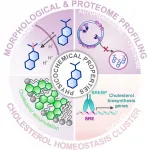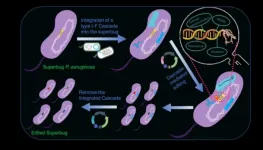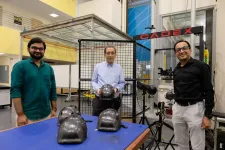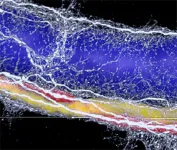Characterized drugs show unexpected effects
Known and yet unexpected: many active substances influence the cholesterol homeostasis and thereby possibly a SARS-CoV-2 infection
2021-07-22
(Press-News.org) When Alexander Flemming discovered a mould on a culture plate overgrown with bacteria in 1928, he did not expect to find one of the most widely used active substances: penicillin. Accidental discoveries and the identification of active ingredients from traditional remedies, such as the morphine of the opium poppy, have shaped the discovery of new medicines for a long time.
Modern drug discovery - from chance to system
Meanwhile, major developments in chemistry and molecular biology have been made that enable a systematic and targeted search for potential active substances in modern drug discovery. First, advances in the field of organic and especially combinatorial chemistry made it possible to produce huge substance libraries and test them for their pharmacological effect in high-throughput tests. Following technological advances like the sequencing of the human genome and the development of new methods in molecular biology enabled the identification of disease-related cellular processes and their molecular key players. This paved the way towards modern drug discovery, where large libraries of molecules are screened in a high-throughput manner for their influence on relevant target molecules, mostly proteins. Identified substances, so-called hits, are optimized in their chemical structure to lead structures that are already effective in small doses and are well absorbed and distributed in the body.
No effect without side effects
This target-based drug development is very successful in identifying new drug candidates that prevent the target proteins from functioning or interacting with other proteins. However, potential drug candidates are rarely specific and very often also act on related proteins that have a similar function or structure. "It is not uncommon that an initially promising drug candidate unexpectedly shows serious side effects in a later phase of its longstanding development, thus limiting or even preventing its clinical use," says Slava Ziegler.
In search of unknown bioactivities
In order to track down possible side effects during drug development, potential drug candidates are screened in assays for their effect on known protein classes, biological processes and certain cellular properties. However, these tests can only reflect the expected bioactivity since the number of known target molecules in the cell is limited. So-called profiling approaches now offer the possibility of detecting a wider spectrum of activity. These unbiased tests investigate the influence on hundreds of cellular or genetic parameters recorded in a substance's profile that is compared with profiles of reference substances with known effects.
When drug profiles match
In their latest study, the group of Herbert Waldmann and Slava Ziegler combined two of these profiling approaches to identify bioactive substances from a library of about 15000 natural product-inspired molecules and compared them with the profiles of known, active compounds. Applying the Cell Painting Assay, where functional areas of the cell are stained and then microscopically examined for changes, a large cluster of substances with similar profiles was identified. However, it was not possible to predict the mode of action of the cluster since the associated reference compounds had various activities or target molecules. With a subsequent search using proteome profiling, in which the quantities and thus the regulation of thousands of proteins was examined, the researchers were able to narrow down the cluster to a common activity - the modulation of cholesterol homeostasis - an unexpected biological activity for the most reference substances in the cluster.
Two birds with one stone: identifying new bioactivities and side effects
But how can substances with very different target molecules trigger the same effect? The researchers revealed that most of the compounds in the cluster accumulate in the lysosome, an organelle where cholesterol is stored temporarily for its further function in the cell. The lysosome has a lower pH value than the rest of the cell, and this is crucial for the functioning of the lysosomal digestive enzymes that process foreign and the cell's own biomolecules. In the lysosome, the substances from the cluster described increase the pH value and thus disrupt the function of this organelle and, in particular, the cholesterol balance of the cell. The fact that the compounds accumulate in the lysosome is not due to a specific target molecule in the lysosome but to their chemical and physical properties, which they have obtained through their structural optimization for improved solubility.
"Interestingly, disturbed cholesterol balance has already been linked to some drugs on the market, such as antipsychotics" notes Tabea Schneidewind, first author of the study. " With the combination of the two search strategies, we can kill two birds with one stone: unveil unknown side effects and identify new active substances and modes of action" says Slava Ziegler.
Targeting cholesterol homeostasis could possibly also disturb SARS-CoV-2 infections
Influencing cholesterol homeostasis seems to be a common feature of many compounds and should be taken into account when evaluating side effects of active substances. However, the observed activity is not per se undesired. Currently, drugs and compounds with known modes of action are being intensively studied for inhibition of SARS-CoV-2 infection of host cells, and many compounds of our cluster have been identified to suppress this process. Interestingly, membrane cholesterol and thus proper cholesterol homeostasis are crucial for Sars-CoV-2 infection as shown in several studies. Our data most likely explain the reason for the activity of these compounds against the virus: they alter cholesterol biosynthesis and localization in cells, which impairs Corona-Virus infection", says Slava Ziegler.
INFORMATION:
[Attachments] See images for this press release:

ELSE PRESS RELEASES FROM THIS DATE:
2021-07-22
TROY, N.Y. -- An innovative testing platform that more closely mimics what cancer encounters in the body may allow for more precise, personalized therapies by enabling the rapid study of multiple therapeutic combinations against tumor cells. The platform, which uses a three-dimensional environment to more closely mirror a tumor microenvironment, is demonstrated in research published in Communications Biology.
"This whole platform really gives us a way to optimize personalized immunotherapy on a rapid, high throughput scale," said Jonathan Dordick, Institute Professor of chemical and biological engineering and member of the Center for Biotechnology and Interdisciplinary Studies (CBIS) at Rensselaer Polytechnic Institute, ...
2021-07-22
It's a favourite first-order for the day, but while a quick coffee may perk us up, new research from the University of South Australia shows that too much could be dragging us down, especially when it comes to brain health.
In the largest study of its kind, researchers have found that high coffee consumption is associated with smaller total brain volumes and an increased risk of dementia.
Conducted at UniSA's Australian Centre for Precision Health at SAHMRI and a team of international researchers*, the study assessed the effects of coffee on the brain among 17,702 UK Biobank participants (aged 37-73), finding that those who drank more than six cups of coffee a day had a 53 per cent increased risk of dementia.
Lead researcher and UniSA PhD candidate, ...
2021-07-22
Silicon, a semi-metal, bonds in its natural form with four other elements and its three-dimensional structure takes the form of a tetrahedron. For a long time, it seemed impossible to achieve the synthesis and characterisation of a two-dimensional equivalent - geometrically speaking, a square. Now scientists from the field of Inorganic Chemistry at Heidelberg University have succeeded in producing a crystalline complex with such a configuration. PD Dr Lutz Greb from the Institute of Inorganic Chemistry underlines that it has surprising physical and chemical properties and, in the field of molecular chemistry, will open up new approaches to using the second most abundant element in the Earth's crust for catalysis and materials research.
As a classical ...
2021-07-22
The touchscreen technology used in billions of smartphones and tablets could also be used as a powerful sensor, without the need for any modifications.
Researchers from the University of Cambridge have demonstrated how a typical touchscreen could be used to identify common ionic contaminants in soil or drinking water by dropping liquid samples on the screen, the first time this has been achieved. The sensitivity of the touchscreen sensor is comparable to typical lab-based equipment, which would make it useful in low-resource settings.
The researchers say their proof of concept could one day be expanded for a wide range of sensing applications, including for biosensing or medical diagnostics, right from the phone in your pocket. The results are reported ...
2021-07-22
Many applications, from fiber-optic telecommunications to biomedical imaging processes require substances that emit light in the near-infrared range (NIR). A research team in Switzerland has now developed the first chromium complex that emits light in the coveted, longer wavelength NIR-II range. In the journal Angewandte Chemie, the team has introduced the underlying concept: a drastic change in the electronic structure of the chromium caused by the specially tailored ligands that envelop it.
Many materials that emit NIR light are based on expensive or rare metal complexes. Cheaper alternatives that emit in the NIR-I range between 700 and 950 nm have been developed but NIR-II-emitting complexes of non-precious metals remain extremely rare. Luminescence in the NIR-II range (1000 to 1700 ...
2021-07-22
A research team led by Wim Annaert (VIB-KU Leuven) uncovered the early assembly of gamma-secretase, a protein complex linked to numerous cellular processes including the development of Alzheimer's disease. In a first step, two dimeric subcomplexes are formed, which independently exit the ER and only afterwards assemble into a four-subunit complex. This 'buckle up' mechanism is thought to prevent premature assembly and activity. The new insights are very relevant, as gamma-secretase is an important potential therapeutic target for Alzheimer's and other ...
2021-07-22
A research team led by Dr Aixin YAN, Associate Professor from the Research Division for Molecular & Cell Biology, Faculty of Science, in collaboration with Honorary Clinical Professor Patrick CY WOO from the Department of Microbiology, Li Ka Shing Faculty of Medicine, the University of Hong Kong (HKU), reported the development of a transferrable and integrative type I CRISPR-based platform that can efficiently edit the diverse clinical isolates of Pseudomonas aeruginosa, a superbug capable of infecting various tissues and organs and a major source of nosocomial infections. The ...
2021-07-22
As cities worldwide expand their networks of cycling paths and more cyclists take to the streets, the chances of cycling accidents and potential collisions increase as well, underscoring the need for proper cycling safety in dense urban areas.
According to a World Health Organisation report in 2020, more than 60 per cent of the reported bicycle-related deaths and long-term disabilities are a result of accidents with head injuries.
Researchers from Nanyang Technological University, Singapore (NTU Singapore), in collaboration with French specialty materials leader Arkema, have developed a tougher, safer bicycle helmet using a combination of materials. The new helmet prototype has higher energy absorption, reducing the amount of energy ...
2021-07-22
With the application of a novel three-dimensional imaging technology, researchers at Karolinska Institutet in Sweden have discovered that one portion of the autonomic nervous system in the liver undergoes severe degeneration in non-alcoholic fatty liver disease. The study, which is conducted in mice and human liver tissue, shows that the degeneration of nerves is correlated with the severity of liver pathology. The results are being published in the journal Science Advances.
Non-alcoholic fatty liver disease is the most common hepatic disorder, with prevalence around 25 percent globally. Approximately ...
2021-07-22
The building sector in the U.S. accounts for 39 percent of energy use, with commercial buildings responsible for about half of that. As cities grapple with climate change, making commercial buildings more efficient is a key part of the solution.
Researchers at the University of Pittsburgh Swanson School of Engineering and the Mascaro Center for Sustainable Innovation used the City of Pittsburgh to create a model built upon the design, materials and purpose of commercial buildings to estimate their energy usage and emissions. While other models may ...
LAST 30 PRESS RELEASES:
[Press-News.org] Characterized drugs show unexpected effects
Known and yet unexpected: many active substances influence the cholesterol homeostasis and thereby possibly a SARS-CoV-2 infection




